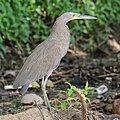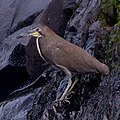Superregnum: Eukaryota
Regnum: Animalia
Subregnum: Eumetazoa
Cladus: Bilateria
Cladus: Nephrozoa
Superphylum: Deuterostomia
Phylum: Chordata
Cladus: Craniata
Subphylum: Vertebrata
Infraphylum: Gnathostomata
Superclassis: Tetrapoda
Cladus: Reptiliomorpha
Cladus: Amniota
Classis: Reptilia
Cladus: Eureptilia
Cladus: Romeriida
Subclassis: Diapsida
Cladus: Sauria
Infraclassis: Archosauromorpha
Cladus: Crurotarsi
Divisio: Archosauria
Subsectio: Ornithodira
Subtaxon: Dinosauromorpha
Cladus: Dinosauria
Ordo: Saurischia
Cladus: Theropoda
Cladus: Neotheropoda
Infraclassis: Aves
Cladus: Euavialae
Cladus: Avebrevicauda
Cladus: Pygostylia
Cladus: Ornithothoraces
Cladus: Euornithes
Cladus: Ornithuromorpha
Cladus: Ornithurae
Cladus: Carinatae
Parvclassis: Neornithes
Cohors: Neognathae
Ordo: Pelecaniformes
Familia: Ardeidae
Subfamilia: Tigrisomatinae
Genus: Tigrisoma
Species: T. fasciatum - T. lineatum - T. mexicanum
Name
Tigrisoma Swainson, 1827
References
(The) Zoological Journal. 3 p. 362
Vernacular names
English: Tiger-heron
suomi: Tiikerihaikarat
português: Socó-boi
Tigrisoma is a genus of herons in the family Ardeidae.
The genus was erected by the English naturalist William Swainson in 1827, with the rufescent tiger heron (Tigrisoma lineatum) as the type species.[1][2] The genus name combines the Ancient Greek tigris, meaning "tiger" and sôma, meaning "body".[3]
Species
Three species are placed in the genus:[4]
| Image | Name | Common name | Distribution |
|---|---|---|---|
 |
Tigrisoma mexicanum | Bare-throated tiger heron | from Mexico to northwestern Colombia, with one recorded sighting from the United States in Hidalgo County, Texas |
 |
Tigrisoma fasciatum | Fasciated tiger heron | from Costa Rica through northwestern Argentina, southeastern Brazil, and Guyana; it has been recorded as a vagrant in Nicaragua |
 |
Tigrisoma lineatum | Rufescent tiger heron | Central America through much of South America |
Beautiful in flight, great markings on the feathers. Nest that mostly resembles jumble pile of twigs with openings large enough to allow eggs to fall through. Calls sounds like sick cow. A contrast in elegance and coarseness.
References
Swainson, William John (1827). "On several groups and forms in ornithology, not hitherto defined". Zoological Journal. 3: 343-363 [362].
Mayr, Ernst; Cottrell, G. William, eds. (1979). Check-list of Birds of the World. Volume 1 (2nd ed.). Cambridge, Massachusetts: Museum of Comparative Zoology. p. 234.
Jobling, James A. (2010). The Helm Dictionary of Scientific Bird Names. London: Christopher Helm. p. 386. ISBN 978-1-4081-2501-4.
Gill, Frank; Donsker, David, eds. (2019). "Ibis, spoonbills, herons, hamerkop, shoebill, pelicans". World Bird List Version 9.2. International Ornithologists' Union. Retrieved 17 July 2019.
Retrieved from "http://en.wikipedia.org/"
All text is available under the terms of the GNU Free Documentation License

